
~~~~~~~~~~~~~~~~~~~~~~~~~~~~~~~~~~~~~~~~~~~
Live Earth Farm (Com)Post
9th Harvest Week, Season 13
June 2nd - 8th, 2008
~~~~~~~~~~~~~~~~~~~~~~~~~~~~~~~~~~~~~~~~~~~
In this issue
--Greetings from Farmer Tom
--Crop update
--Newcomers Welcome!
--Update from TLC Ranch (eggs!)
--Eating Locally
--Pictures around the farm
--What's in the box this week
--Notes from Debbie's Kitchen
--Calendar of Events
--Contact Information
"Everything that slows us down and forces patience,
everything that sets us back into the slow circles of nature, is a help."
~
May Sarton (from ‘Gardening by Heart’, by Joyce Mc Greevy)
Greetings from Farmer Tom
~~~~~~~~~~~~~~~~~~~~~~~~~~~~~~~~~~~~~~~~~~~~~~~~
I’m glad no one had a camera handy to catch me last week in what I would in hindsight call an act of entertaining foolishness. As I was riding my bike past the apricot orchard I spotted this young deer munching away on the trees' succulent branches. I don't know what triggered it, but I jumped off the bike and started chasing it as if driven by some primitive hunting instinct. The furry antlered young buck stood still for a moment, as though astonished by my behavior, then bounded away effortlessly; meanwhile I stumbled over a dirt clod and fell to the ground. Sitting there under an apricot tree I had to laugh at myself. My only thought at that moment had been to stop this ‘uninvited guest’ from munching on our crops. All tolerance – thoughts of coexistence or deeper sense of interdependence – had just evaporated. My ‘generosity’ in terms of sharing the bounty of our fields with other beings had reached the saturation point. Earlier I’d noticed that gophers had been particularly busy eating entire rows of developing tomato plants; meanwhile on the other side of the strawberry patch our goats had been escaping through some hole in their fence and munching on the young trees we planted just this spring, as well as stripping leaves off the first succulent raspberry shoots.
Fundamentally I consider myself to be someone who strives to farm in an environment where cultivated fields can exist side by side with areas of wilderness. I enjoy being able to step from the more controlled and production-oriented farm fields into the wilder haunts of the woods. Most of our fields are bordered either by woodlands (oak or redwood), riparian habitats (along the banks of small ponds and seasonal streams), or thick hedgerows filled with a diversity of native vegetation. Many species, both vertebrate and invertebrate, have evolved in these wilder habitats and consider them home, so it is hard at times to distinguish who is pest and who is guest. If we turn the table for a moment and that deer had its say, I probably wouldn't stand much of a chance in an argument over who is guest and who is pest. I am the recent arrival – raised in Latin America by European parents, a city kid turned farmer – so when it comes to who has the seniority claim on this piece of land I am by far more invasive than native.
Weeds are the exception, the one place where I make no excuse for losing my mostly peaceable and coexistent nature as an organic farmer. Controlling the wilderness of weeds that compete with our crops sometimes seems like a hopeless task. No organic control practice seems ‘controlling’ enough. Just last week I had to throw in the towel, when a spring sown crop of carrots were so thick with weeds that it took eight of us an hour to harvest 60 bunches. We gave up and plowed them under. Remember just two weeks ago when I talked about how timing is everything when it comes to weeding? Well between the frost then the heat wave then the fire, this planting of carrots did not get weeded at the correct moment. Weeding reminds me of Sisyphus, the Greek mythic figure that endlessly attempts to push a rock uphill. In the clarity of hindsight I should have either planted these carrots where the soil wasn't so heavy, or waited to plant them until after having removed the first flush of weeds.
If walking into the wilder corners of the farm doesn't help me shed my MacGregor-like worry though (about protecting every crop we grow from some sort of pest or disease), then spending time with the many children visiting us every week does. Their joyous, spontaneous and creative interaction with the farm never fails to shine a more playful perspective on that hopeless image of Sisyphus. It reminds me of the Buddhist teaching about how everything changes all the time, and that I must embrace the fact that farming is one of stewardship and not ownership of the earth.
- Tom
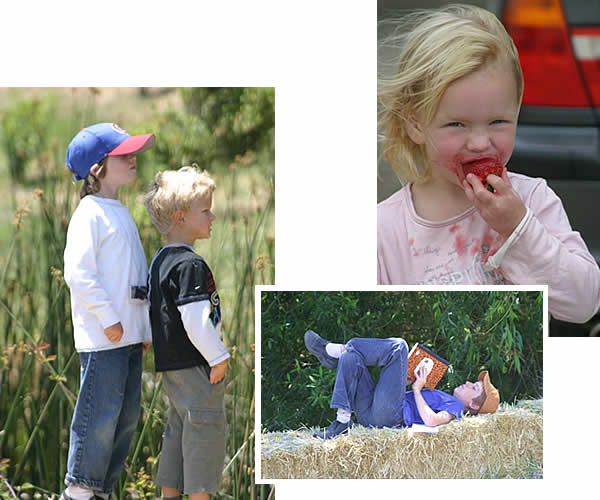
<back to top>
Crop update
~~~~~~~~~~~~~~~~~~~~~~~~~~~~~~~~~~~~~~~~~~~~~~~~
Strawberries continue to be bountiful, while the first ollalieberries [blackberries]
are starting to ripen. The birds are already sampling them, a good sign we can
start harvesting soon. This week everyone will get a nice quantity of Lebanese
summer squash, my favorite variety, which has an exquisite nutty flavor. 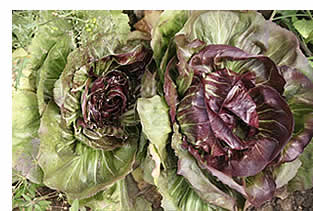 Soon,
probably starting next week, we'll introduce everyone to radicchio (pictured),
and red beets should also make their appearance again. Barring any other infestations
of weeds, carrots should be back in about two weeks, and potatoes in three. The
avocados in this week's Family Share come from Steve Marsalisi, a neighboring
farmer (just down the road from us) who has supplied us every year. This year
his harvest will be low due to last year’s heavy spring frost. The variety
is called “Bacon.” Green
Beans are struggling with the cool weather, but my best guess is that we'll have
them sometime by the end of June – just in time for the start of the summer
season!
Soon,
probably starting next week, we'll introduce everyone to radicchio (pictured),
and red beets should also make their appearance again. Barring any other infestations
of weeds, carrots should be back in about two weeks, and potatoes in three. The
avocados in this week's Family Share come from Steve Marsalisi, a neighboring
farmer (just down the road from us) who has supplied us every year. This year
his harvest will be low due to last year’s heavy spring frost. The variety
is called “Bacon.” Green
Beans are struggling with the cool weather, but my best guess is that we'll have
them sometime by the end of June – just in time for the start of the summer
season!
<back to top>
Newcomers Welcome!
~~~~~~~~~~~~~~~~~~~~~~~~~~~~~~~~~~~~~~~~~~~~~~~~
This week we are starting about fifty new members off our waiting list, so to
those of you who are new to our CSA this week – welcome!! If you
have the time, we highly encourage you to do a little ‘homework’ and
peruse the newsletters of the weeks you missed; lots of good information and
a great way to jump-start you into the flow of things, bring you up to speed
with everyone else :-)
You can find past newsletters on our website; they are posted each week after
being emailed out. If you just want to jump there now, click
here.
Also, don’t forget to mark your calendar for our Summer
Solstice Celebration,
which is coming right up: Saturday June 21st. Hope to see you all on the farm! – Debbie
and Farmer Tom
<back to top>
Update from TLC Ranch (eggs!)
~~~~~~~~~~~~~~~~~~~~~~~~~~~~~~~~~~~~~~~~~~~~~~~~
This just in from Jim Dunlop at TLC Ranch:
“TLC Ranch brown eggs come from laying hens raised on organic pasture,
fed all organic feed from Modesto Milling and organic cull vegetables from local
organic farms. They are rotated weekly onto fresh pasture using portable
hen houses, electric fencing, and a guard dog to keep our predators. Our
pastures are kept green and healthy through careful rotation and year-round irrigation,
ensuring fresh forage for the hens to keep busy with. Our eggs are naturally
high in Omega-3 fatty acids because these good fats are found in the growing
plants that our hens consume. Grain-fed animals are high in Omega-6 fatty
acids because these fats are found in the grain. That is why a grass or
pasture-raised animal has a higher Omega-3 profile, and thus, a healthier ratio
of fatty acids that protect your heart. Our eggs are also higher in Vitamin
A, iron, and have lower cholesterol and saturated fat than a barn-raised egg. For
truly free-range eggs, sign up for a TLC Ranch egg share.”
We do indeed still have egg shares available, so if you were on the fence about
it, hop off now and contact Debbie at the
farm to
find out how to get some of Jim’s
terrific eggs with your share!
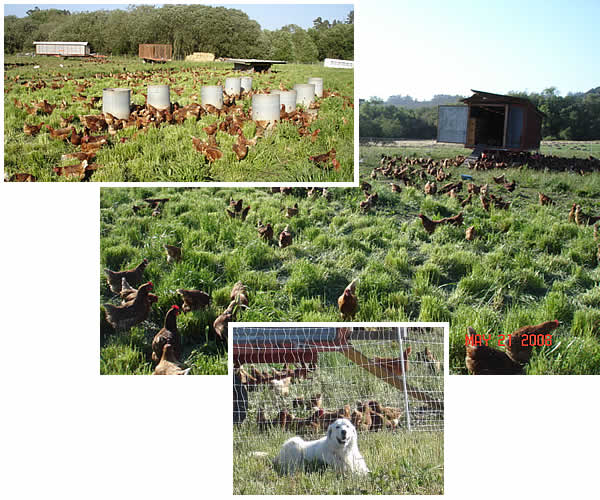
<back to top>
Eating Locally
~~~~~~~~~~~~~~~~~~~~~~~~~~~~~~~~~~~~~~~~~~~~~~~~
Longtime member Farrell Podgorsek wrote in with this to say:
“This week, in addition to our veggie share from Live Earth Farm, we will
pick up our Morris Grassfed Beef, and I'll roast the new summer squash and serve
it with a locally raised grassfed steak. Yum! With the assortment
of vegetables and fruits from Live Earth Farm and beef from Morris Grassfed,
and eggs fro TLC Ranch, we can eat locally and support farm raised, sustainable
agriculture and holistically raised beef and eggs. Organic wine and a dessert
including TLC eggs will top off the meal.
“Our family had a delicious celebration dinner on Mother's Day, and when
we stopped to examine where our food came from, virtually everything was produced
and grown in the Bay Area. It was a wonderful feeling to know we were supporting
family farmers and ranchers who are doing their best to create a sustainable,
Holistic environment, where the producer, product, land and consumer all benefit. That
was a special Mothers Day benefit for me.” - Farrell
[You already know about getting eggs through us (from TLC Ranch, see above),
but if you are interested in sourcing your beef locally, and from animals that
spend their lives on pasture, Morris Grassfed Beef is an excellent way to go.
I can’t
say enough good about Joe and Julie Morris and the integrity of their product.
For more information, visit their website: http://www.morrisgrassfed.com – Debbie]
<back to top>
Pictures around the farm
~~~~~~~~~~~~~~~~~~~~~~~~~~~~~~~~~~~~~~~~~~~~~~~~
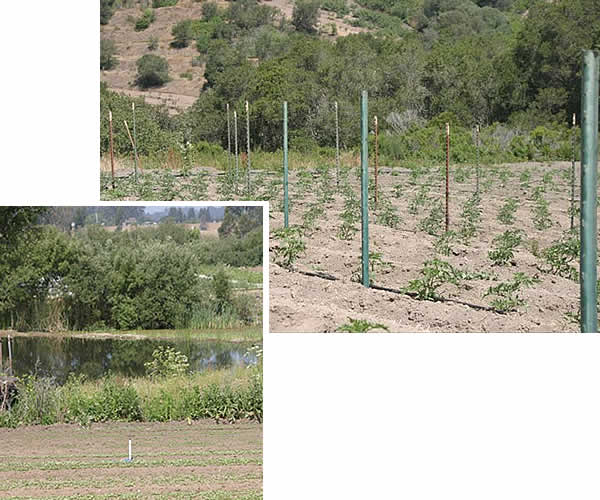
Here are some examples of the interfaces between wildlands (pond, forest)
and our farm's fields...
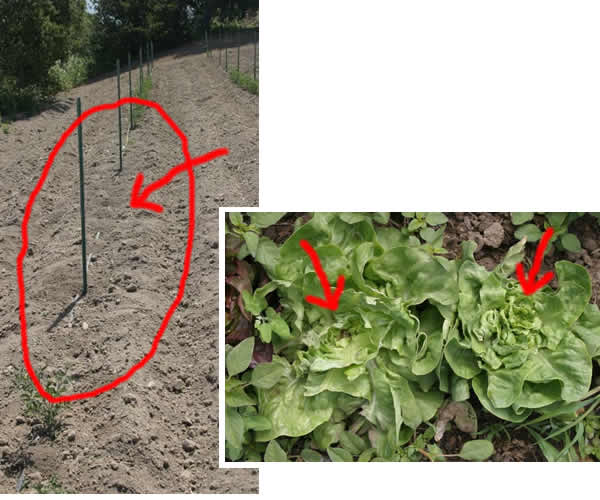
...and some examples of the consequences of that wildland interface.
Note the gap in the row of tomato plants at left (gophers), and the hearts
eaten out of heads of tender lettuce (deer).
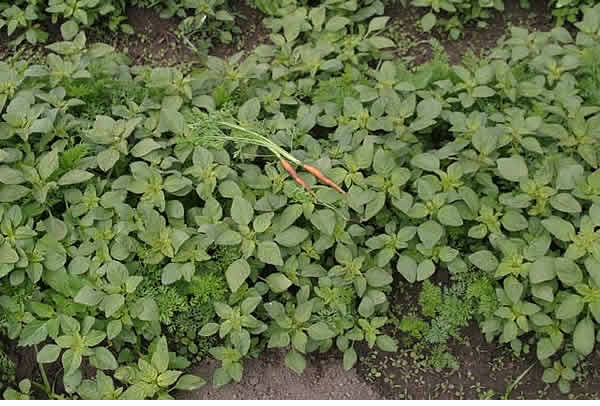
Here's an example of what happens if we aren't vigilant about keeping
the weeds under control. This is the carrot planting we had to plow
under.
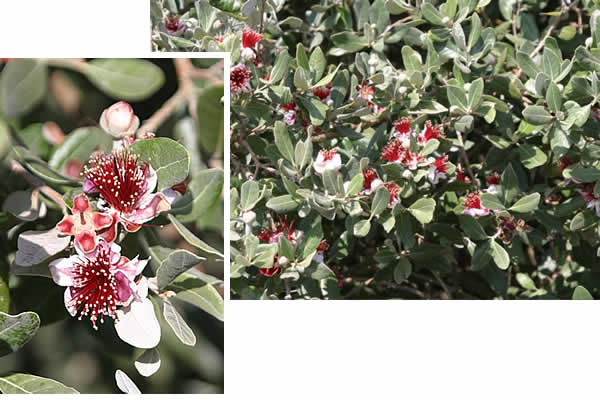
But then there is always the simple yet awe-inspiring beauty of plants
in flower; here are the blossoms from our pineapple guava bushes, whose
fruit won't be ripe until late fall/early winter.
<back to top>
What's in the box this week
~~~~~~~~~~~~~~~~~~~~~~~~~~~~~~~~~~~~~~~~~~~~~~~~
Content differences between Family and Small
Shares are in red; items
with a “+” in
Family Shares are more in quantity than in Small; anticipated quantities, if
any, are in parentheses, as are the source of any produce if not from Live Earth
Farm (LEF). Occasionally content will differ
from this list (typically we will make a substitution), but we do our best to
give you an accurate projection.
Family Share:
Arugula +
Avocados (Marsalisi Farm)
Cauliflower (Lakeside)
Chard
Chinese (Napa) cabbage
Kale
Lettuce +
Mizuna +
Onions +
Radishes
Spinach +
Summer
squash +
Strawberries (should be 3 baskets, but go by what’s next to your name on
the checklist)
Small Share:
Arugula
Cauliflower (Lakeside)
Chard
Chinese
(Napa) cabbage
Lettuce
Mizuna
Onions
Radishes
Spinach
Summer
squash
Strawberries (should also be 3 baskets, but go by what’s next to your name
on the checklist)
Extra Fruit Option:
should be 5 baskets of strawberries (again,
go by checklist for final number)
-- blackberries coming soon...! --
Fruit "Bounty" Option:
also 5 baskets of strawberries (ditto re: checklist)
<back to top>
Notes from Debbie's Kitchen
~~~~~~~~~~~~~~~~~~~~~~~~~~~~~~~~~~~~~~~~~~~~~~~~
Hello everyone, and welcome new members! If you’re new to the farm,
you may not be aware that we have an extensive database of recipes
for you on the website! So when inspiration just isn’t striking, go there and you’re
almost guaranteed to get some good ideas! Here’s the link if you want to
take a peek: (click
here to go to recipe database)
Meanwhile, this week I have contributions from members with ideas for preparing
mizuna, summer squash, cauliflower and radishes, and since we’re getting
LOTS of spinach again (sez Tom), and everyone’s getting Chinese/Napa cabbage,
I’ll just have to include something about them too! Oh, and FYI, I have
a habit of inserting my two cents into other people’s recipes; when I do,
I put my comments [in square brackets]. – Debbie
Many Mizuna Ideas
A member who prefers to remain anonymous (he’s
shy!) sent me these great suggestions. He, his wife and two children manage
to consume TWO family shares a week, mind you, so I know they know what to
do with greens!
We eat mizuna in many ways, but here are just a few:
As a salad. Toss mizuna with whatever other salad goodies you like. Any
and all. [Let’s see, from this week’s box you could add lettuce,
spinach, arugula, sliced radishes... maybe matchsticked summer squash!] Here’s
one way I like to go: I’ll take orange slices, roasted cashews, and cubed
jicama and toss them together into a kind of salsa, with a home made orange-honey
dressing. We serve a pile of Mizuna (with or without other goodies) and spoon
helpings of the above "relish" on top and chow down! The orange-honey
dressing is simply frozen orange juice concentrate thinned with just enough water
(or olive oil or any liquid, incl. wine) to reach a desired consistency, then
combined with a little honey. I have no precise measurements; all done by tastes.
You adjust and add as you wish.
Stir-Fry. This is wonderful with green garlic. [Hm, new folks, you’ll
have to scare up some garlic – we just stopped putting green garlic in
the boxes last week! But the rest of us still have lots of it in our refrigerators...
at least I do!] Divide green garlic into two parts: the green top and the lower
half including the bulb. Slice the bulb portion and slice the green top portion.
Heat a pan to cooking temperature, add oil, then quickly add in sliced bulb
portion and let it sear for 5-7 seconds or so, or until the garlic aroma hits
the nose, then add in the green top portion and stir a bit and cover. Let sit
for 10 seconds or so, then add Mizuna and start tossing until it just begins
to go limp (not until wilted). Cover for 10 more seconds or so and serve. Basically
it’s a quick hot-tossed Mizuna with garlic. [Me, I’d probably add
some salt, but that’s ‘cause I’m a salt fiend.] The green
garlic tops take longer to cook than the mizuna, so add it to the pan first.
The desirable texture is ‘just-cooked mizuna’, not ‘dead
and wilted mizuna’... with sparkingly garlicky flavors.
Other methods. We like using fresh Mizuna as a bed for cooked goodies.
The fresh greens counter-balance the cooked and seasoned flavors of the goodies
on top: Stir-fry sliced beef in various sauces and pour on top of a bed of
fresh Mizuna (sliced to bite size) to serve. Curry stewed vegetables or meat
on top of Mizuna, or braised tofu or braised shitake on top of Mizuna. Be creative!
In the end, I just cook with whatever is on hand and make the best of it, so
it is hard to provide measurements. Sometimes I cannot repeat what everyone likes
because the ingredients are gone or proportions are forgotten! :-). [This is
the kind of cooking I like to encourage though! It’s all about ‘cooking
with what you have’ in my book!]
Here’s an undated Bon Appetit recipe I modified to use mizuna (it just
says ‘greens’ and mentions mustard greens, so since mizuna is a mustard
green, I think it will be just fine!)
Penne with Greens [Mizuna], Olives, and Feta
serves 4 to 6
“Greens are paired with salty olives and feta – to great effect.
The greens cook in the pasta water, making this an efficient one-pot meal.”
¼ C chopped fresh Italian parsley
1 tsp. finely grated lemon peel
1 garlic clove, minced
1 large bunch of greens (such as spinach, mustard greens, kale, or broccoli rabe;
about 1 lb.), stems removed (except for spinach), torn up
12 oz. penne pasta
5 tbsp. olive oil, divided
½ C coarsely chopped pitted Kalamata olives
½ C crumbled feta cheese (about 3 oz.)
Mix parsley, lemon peel and garlic in small bowl; set aside.
Bring large pot of salted water to boil. Add greens and cook just until tender,
1 to 6 minutes, depending on type of greens [the mizuna would be a minute or
less!! Probably more like 30 seconds or so]. Using skimmer or slotted spoon,
transfer greens to colander to drain. Return water to boil. Add pasta and cook
until just tender but still firm to bite, stirring occasionally. Drain, reserving ¾ C
pasta cooking liquid. Return pasta to pot; add greens and 3 tbsp. oil and toss.
Stir in olives, feta, and enough reserved pasta cooking water by ¼ cupfuls
to moisten. Season with salt and pepper. Transfer to bowl. Drizzle with remaining
2 tbsp. oil, then sprinkle with parsley mixture and serve.
Farrell’s Favorite Summer Squash
from longtime member Farrell Podgorsek
My favorite way to eat Summer Squash is to cut them in half, coat them with olive
oil, salt and pepper and place on a cookie sheet. Roast in a hot oven – 400
degrees – until they are softened and browned (You can use a lower temperature
and bake longer). When the squash are done, remove from the oven and sprinkle
fresh herbs and chopped garlic on them. If using green garlic, sauté it
first in some olive oil until soft and golden before tossing it with the squash.
Serve hot or at room temperature. Leftover squash is also nice cubed and
tossed with balsamic vinegar, then stir it into cooked grains such as Israeli
Couscous or rice.
Cauliflower Puree (instead of mashed potatoes)
another Farrell contribution
Steamed and pureed cauliflower is wonderful. It has a smooth, silky texture
and nice flavor, and is a fun, healthy alternative to mashed potatoes. To make
my version, cut as much cauliflower as you want to make into small pieces. If
stems are used, cut them into smaller pieces than the florets so they cook quickly.
Place the cauliflower in a steamer insert over boiling water. Cook until
completely soft when pierced with a knife. Transfer cauliflower to a food
processor and blend until completely pureed. You can add cooking water or milk
to thin it out if too thick. Salt & pepper to taste. I don't,
but olive oil or butter can be added to enrich the puree. You can also
stir in some minced herbs - sage is wonderful with cauliflower. If you
like, steam some garlic with the cauliflower and puree together.
Radish Pickles
From member Karen Fox, who says, “I
love radishes but my family is ‘so-so’ on
them, but then I tried this recipe and my kids devoured these tasty pickles!”
2 C water
6 tbsp. wine
6 tbsp. balsamic vinegar
1/2 C olive oil
2 tbsp. honey
Fresh thyme, rosemary, basil, oregano, parsley (used what we have in our herb
bed...)
Boil together all ingredients to mix, then add small French radishes, baby pearl
onions, tiny carrots as thick as your finger. Bring to a rolling boil again (don't
let them get squishy), let cool in the pan then refrigerate overnight. Serve
cold as a garnish, or add to recipies that use pickles: tuna salad, potato salad...
The flavor is mild, sweet and tangy with the essence fresh herbs. The radishes
retain their crunch and have a mild flavor and less bite. I strained the liquid
before storing the leftover veggies in a jar though, as the herbs looked a little
sad!
Here’s a pair of I ran back in 2003 that I
thought bore repeating...
Simple Cooked Chinese Cabbage
from Vegetarian Cooking for Everyone, by Deborah Madison
This Asian cabbage cooks quickly and is even milder than European varieties.
Allow 1 1/2 lbs. or more for 4 servings. Chop the whole cabbage, including the
firm white base, into strips of whatever width appeals to you. Heat a few tablespoons
water or rice wine in a wide skillet, add the cabbage, and sprinkle with salt.
Cook over medium-high heat, turning the leaves with tongs, until wilted. Drain,
then toss with dark sesame oil, roasted peanut oil, or butter. Garnish with chopped
parsley, cilantro or dill; snipped chives; toasted sesame seeds, or Gomashio
(a mixture of black and white sesame seeds and sea salt).
Cold Chinese Cabbage with Cilantro
from Chez Panisse Vegetables by Alice Waters
Macerate finely diced shallots in white wine vinegar for 15 minutes or so. Slice
Chinese or Napa cabbage very thin, toss with the shallots and vinegar, some good
olive oil, and salt and pepper. Let the cabbage sit about 10 minutes so it starts
to wilt. Add a handful of fresh cilantro leaves and serve.
Lastly, here’s a (spinach) recipe I made
up a few years back. Simple, easy, tasty!
Debbie’s Chorizo and Eggs Florentine
Cook a bunch of cleaned spinach in boiling salted water for about a minute (alternatively
you can steam it just until wilted). Drain, squeeze out excess water, chop, and
set aside. Brown up chorizo, scramble in eggs, and when eggs are mostly set,
add spinach and scramble until eggs are done. Top with grated jack cheese (optional)
and serve with warm tortillas, and maybe your favorite salsa or hot sauce!
<back to top>
2008 Calendar of Events
~~~~~~~~~~~~~~~~~~~~~~~~~~~
For details on events listed
below, please Click
here to go to the calendar page on our website.
Santa Cruz Permaculture Design course - one weekend/month for
6 months, Feb-July
Spring "Six Thursdays" Mataganza Garden Internship - every
Thursday from May 1st through June 5th, 10am - 5pm, in the Mataganza
Garden Sanctuary at Live Earth Farm.
Herbalism Classes at Live Earth Farm:
<>Herbal First Aid - March 15-16
<>Medicine Making - May 10-11
<> Cooking with Herbs - July 19-20
Mataganza Garden Sanctuary Open House and Fundraiser -
Sunday June 8th, 3-8pm
Summer Solstice Celebration - Saturday June 21st
Children's Mini-Camp - July 11th - 13th (Friday evening thorugh
Sunday noon; advance reservations required as space is limited)
Fall Equinox Cob Building Workshop and Campout - Sept. 20 and 21
Fine Farm Feast - postponed to 2009
Fall Harvest Celebration - later in October (date TBA)
Contact Information
~~~~~~~~~~~~~~~~~~~~~~~~~~~
email Debbie at the farm (for any farm or CSA share-related business): farmers@cruzio.com
email Debbie at home (with newsletter input or recipes): deb@writerguy.com
farm phone: 831.763.2448
website: http://www.liveearthfarm.net
~~~~~~~~~~~~~~~~~~~~~~~~~~~